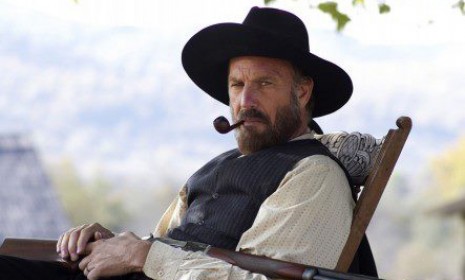Why Hatfields & McCoys broke ratings records: 4 theories
The History channel's miniseries about America's most famous feuding families shockingly is the second most-watched program in cable history. Why was it so popular?

The Walking Dead regularly scares up monster ratings for AMC. Last year's MTV Video Music Awards was the highest rated ever. But neither measures up to the History channel miniseries, Hatfield & McCoys, which just became the second most-watched entertainment program in the history of basic cable television. (Only the Disney channel's 2007 TV movie High School Musical 2 ranks higher.) The three-part miniseries, starring Kevin Costner and Bill Paxton as the patriarchs of the famous feuding families, was History's first foray into scripted programming. The trio of episodes now occupy three of the top four most-watched slots for entertainment shows on cable, led by the finale, which drew 14.3 million viewers. Why was Hatfields & McCoys so popular? Here, four theories:
1. It appealed to older viewers
The key to this ratings win: "Lots and lots of older viewers," says Josef Adalian at New York. Roughly 60 percent of the series' audience qualified for an AARP card. Meanwhile, it only drew 4.9 million viewers under age 50. (The average episode of Jersey Shore attracted 6.2 million under-50s last season.) Plus: Kevin Costner and Tom Berenger are big '80s stars, and their fans tuned in, says James Von Schilling at The Christian Science Monitor.
The Week
Escape your echo chamber. Get the facts behind the news, plus analysis from multiple perspectives.

Sign up for The Week's Free Newsletters
From our morning news briefing to a weekly Good News Newsletter, get the best of The Week delivered directly to your inbox.
From our morning news briefing to a weekly Good News Newsletter, get the best of The Week delivered directly to your inbox.
2. Strong brand building
Niche cable channels, including Bravo, AMC, and History, have brilliantly leveraged one hit series into a promotional launching pad for an entire line-up of similar programming, Syracuse University professor Robert Thompson tells the C-S Monitor. Bravo turned the breakout success of Queer Eye for the Straight Guy into a uniquely branded channel; AMC did the same with Mad Men and its slate of prestige dramas. History heavily cross-promoted Hatfields & McCoys during its surprisingly high-rated reality show Pawn Stars, and scored.
3. It was event TV
Hatfields & McCoys was classic entertainment, and sometimes that's all viewers desire, says Gloria Goodale at the C-S Monitor: "The high production values, the big-name stars, and big budgets." The series had the "old-fashioned appeal of a classic network miniseries," says Greg Evans at Bloomberg. "No Deadwood here." And DVRs make the idea watching an epic, six-hour miniseries all the more appealing, says Contact Music. Viewers can watch the three episodes on a delay in marathon sessions.
A free daily email with the biggest news stories of the day – and the best features from TheWeek.com
4. The feud fascinates people
Interest in the bad blood between the Hatfield and McCoy families clearly hasn't waned over the years, says Bill Carter at The New York Times. The large following for History's miniseries also sparked a surge in sales of books about the clashing clans. The day after the final installment of the miniseries aired, four Hatfield and McCoy books were among the top 10 "Movers & Shakers" on Amazon.
-
 Political cartoons for January 4
Political cartoons for January 4Cartoons Sunday's political cartoons include a resolution to learn a new language, and new names in Hades and on battleships
-
 The ultimate films of 2025 by genre
The ultimate films of 2025 by genreThe Week Recommends From comedies to thrillers, documentaries to animations, 2025 featured some unforgettable film moments
-
 Political cartoons for January 3
Political cartoons for January 3Cartoons Saturday's political cartoons include citizen journalists, self-reflective AI, and Donald Trump's transparency